11th Hospital Train Unit History

Wartime illustration showing the interior of a typical barracks room at Camp Ellis, Illinois. The 11th Hospital Train was activated at Camp Ellis on 10 December 1943.
Activation & Training:
The 11th Hospital Train was officially activated at Camp Ellis, Table Grove, Illinois (Army Service Forces Training Center; acreage 17,503; troop capacity 1,795 Officers & 24,654 Enlisted Men –ed) on 10 December 1943 (per General Orders 85, Headquarters ASFUTC, Camp Ellis, Illinois, 11 December 1943, and War Department Letter AG 322 (30 November 1943) dated 4 December 1943 -ed).
Immediately after its activation, the unit began a period of training and organization – reorganization took place as per T/O & E 8-520 (Hospital Train, dated 12 February 1944 -ed). The cadre was quickly filled with the required personnel and positions. All of the assigned Technicians had previously worked in hospitals before joining the unit. As a result of this, training was relatively minimal, and the only requirement was some refinement and refresher courses in the various techniques unique to a Hospital Train unit.
On 3 May 1944, the unit left Camp Ellis for Camp Myles Standish, Boston, Massachusetts (Staging Area for the Boston Port of Embarkation -ed) where final preparations were made for the unit’s overseas movement.
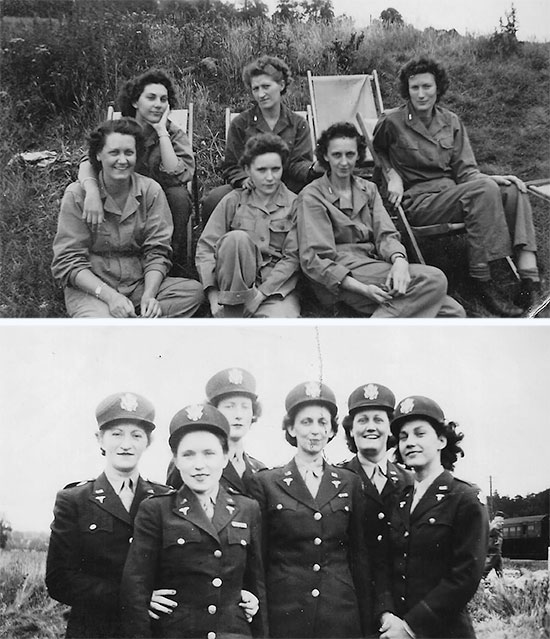
Top: Nurses of the 11th Hospital Train in Exeter, England, July 1944. Front row; from L to R: Nurses Helen Lawrence, Graham, Kennedy. Back row; from L to R: Adrienne Van Houten, Kenny, Watt. Bottom picture taken in Exeter during the same period. From L to R: Nurses Kenny, Graham, Watt, Kennedy, Helen Lawrence, Adrienne Van Houten. Courtesy Van P. Keele.
United Kingdom:
On 13 May 1944, the 11th Hospital Train set sail from the Boston Port of Embarkation aboard SS “Colombie”, finally arriving in the port of Glasgow, Scotland on 23 May. Immediately after debarkation, the unit proceeded from Scotland to England, where it was attached to the 185th General Hospital. At that time, no train had been assigned to the unit, so the personnel were given collateral training at the Hospital. Whenever possible, Officers and Enlisted Men of the unit would visit one of the nearby Hospital Trains that was operating in the surrounding area to prepare fully for their duties.
United Kingdom Stay – 11th Hospital Train
24 May 1944 > 16 July 1944
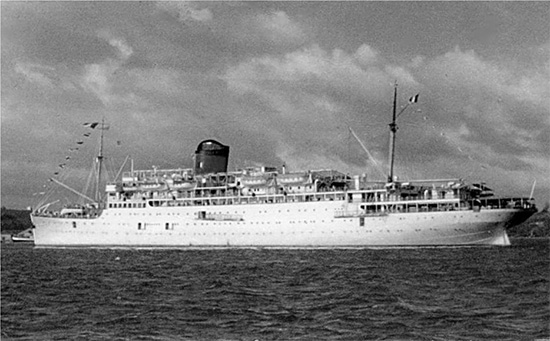
General view of SS “Colombie“, a French-built transport which carried members of the unit from the Zone of Interior to Glasgow, Scotland.
The unit’s attachment to the 185th ended on 13 July 1944, at which time its personnel once again prepared for overseas movement. The destination this time, was to be France. Between 31 May 1944 and 7 June 1944, the 11th Hospital Train’s home station was Moreton-in-Marsh, Gloucestershire, on the main London-Worcester line. From 7 June 1944 to 16 July 1944, the unit’s home was the railway station of Lydeard, Somerset, United Kingdom.
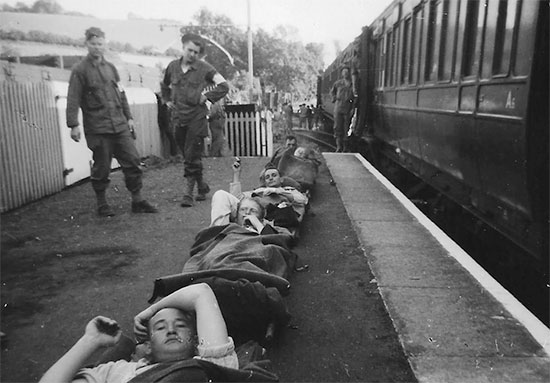
Photograph illustrating 11th Hospital Train personnel with patients in Templecomb, England, July 1944. Courtesy Van P. Keele.
France:
On 16 July 1944, the 11th Hospital Train left the marshaling area in England and sailed for the coast of France. All personnel and equipment landed at Utah Beach on 18 July 1944, making the unit the first of its kind to land in Normandy.
Another record was set on 4 August 1944, when the 11th began operation of the first Hospital Train on the continent. The train comprised of “40 & 8” French box cars fitted with the necessary emergency equipment.
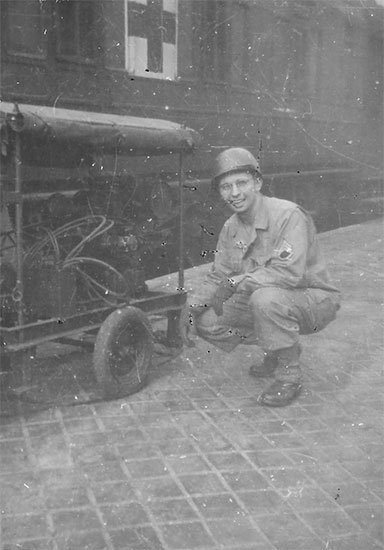
Photograph illustrating Staff Sergeant Richard O. Liptock, Gare St. Lazare, Paris, France, February 1945. Courtesy Van P. Keele.
This primitive set-up brought with it numerous complications. Until the doors were cut through on each end, there was no means of communication between cars. These makeshift ‘doors’ permitted the Doctors and Nurses to care for patients throughout the train, instead of limiting their attention to a single car. One of the carriages was also converted into a kitchen that provided the staff and patients with sandwiches and hot coffee (instead of the K Rations which had previously been the only food available on board the train). The unit’s personnel conducted all conversion work to the train.
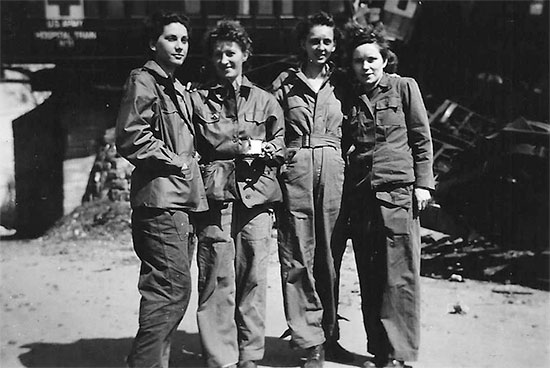
Four Nurses of the 11th Hospital Train pictured in front of train wreckage following the derailment in April, 1945. From L to R: ANC Officers Van Houten, Kenny (Head Nurse), Kennedy, Graham. Courtesy Van P. Keele.
On its initial run, the unit arrived at Lison, collected 208 patients (90 litter cases and 118 ambulatory cases) and departed Lison at 1400 hours on 4 August 1944. The patients were transferred to the 298th General Hospital upon the train’s arrival in Cherbourg.
This improvised train operated on a large route, extending from Cherbourg to Lison and La-Haye-du-Puits, and ceased operation on 1 October 1944. During this period, the 11th Hospital Train evacuated a total of 5,465 patients without a single fatality. For its actions, the unit received a Commendation from the Surgeon, Normandy Base Section, and from the Chief Surgeon, Headquarters, European Theater of Operations.
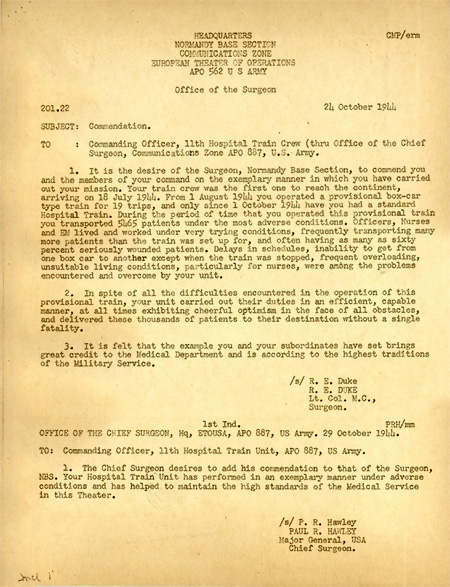
Copy of the official Commendations issued to the 11th Hospital Train by Maj. Gen. Paul R. Hawley and Lt. Col. R. E. Duke (dated 24 October 1944).
On 4 October 1944, a standard Hospital Train was assigned to the unit. Although it was a welcome improvement to the heavily modified box cars that had previously been used, the staff of the 11th also made several improvements to this new train. When it had been first assigned, only a single shower was present (in the Enlisted Men’s car), which was capable of providing only cold water. With the aid of extra pipe, soldering iron and various other items, an outlet was established from the steam pipe and the water was heated. In addition to converting the existing shower, another was installed in the Officers’ car by removing one of the latrines. A public address system was also installed throughout the train, while a radio and record player provided music and news for the patients. Each speaker was equipped with a modulator so that it could be adjusted to suit each car. This system proved very popular with the patients; since there were no windows (except for one in each door), the trip was often tedious.
A sturdy bedside table was constructed for each ward car, with a compartment for food cans. Not only did this allow the ward men to make sandwiches that were hot, but it also enabled them to prepare medications and dressings more easily.

One of the lesser damaged cars of the 11th Hospital Train rests precariously on a road bridge following the derailment. The Geneva Convention symbols are clearly visible here.
Despite many improvements made by the unit’s staff, one complaint about the new setup remained. In cold weather, the diesel engine was incapable of supplying heat to the whole train. Placing the diesel car between the Ambulatory Car and Ward Car #8 solved this. In spite of the fact that a diesel car was attached to the train, the main source of heat was from the French engine. When the train was forced to remain in railyards for any length of time in extremely cold weather, the diesel engine was also found to be inadequate. Steam had to be passed through the pipes at all times from the main engine in order to prevent them from freezing, if the train was without any kind of steam or heat for even a short period, the pipes would freeze solid.

Rescue workers recover dead and wounded personnel from the wreckage, shortly after the cars plunged into the Eure River valley.
On 10 April 1945 while en route from Cherbourg to Paris, the 11th Hospital Train left the rails near Merey and plunged into the valley of the Eure River. At the time of the crash, the train was not carrying patients, but the wreck caused the death of 5 Enlisted Men, and seriously injured 14 others. The entire train (which consisted of British-built bunk type wooden cars) was almost completely destroyed in the derailment, except for a single steel car, which was not part of the original train.
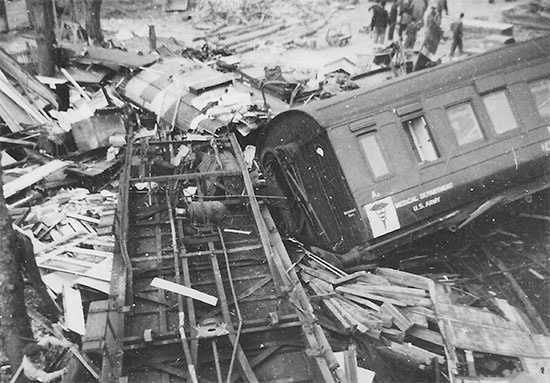
Alternate view of the wreckage showing two heavily damaged cars. Courtesy Van P. Keele.
Dead Personnel – Crash 10 April 1945
William A. Dietrich (32718776)
Paul Kapisovsky (20317004)
Leo Kent (38390689)
Richard O. Liptock (33055778)
Robert H. Phebus (35150715)
Official Report issued and signed by Major William W. Hay, TC, Engineering Section, 710th Railway Grand Division, APO 350, United States Army, dated 13 April 1945, concluded that Hospital Train # 11 consisting of 15 cars and a French engine, on an eastbound route without patients, from Lison to Paris via Lisieux and Mantes, was derailed at the end of double track west of the Eure River railway bridge, while traveling at a high rate of speed (95 km/h). The summary report further stated that the accident took place at 2325 hours, 10 April 1945, on the line Lisieux to Mantes. The probable cause of the derailment was non-observance of the distant slow order board and excessive speed by the engine crew. The derailed cars damaged the switch on the west side of the bridge and tore up the track completely (speed restriction at the location was max. 20 km/h). Only four cars remained on the track and were recovered with virtually no damage. As a result of the accident 5 men were killed and 14 injured, of which 3 very seriously. The majority of the Enlisted Men were from the 343d Medical Battalion Evacuation Point, with 1 EM belonging to the 728th Railway Operating Battalion, and 4 Officers, members of the 4th Hospital Train. The casualties were evacuated on 12 April 1945 with ambulances of the 224th General Hospital, stationed in Evreux. Wrecks were cleared, switches, track, ballast, removed and replaced and made available for service as from 1910 hours, 12 April 1945.
The Office of the Chief of Transport felt that a maximum of 47 trains were still required to operate on the continent at this time, and so a brand new train was released from the Army’s Building Program to replace the destroyed carriages and engine.
France Stay – 11th Hospital Train
18 July 1944 > 31 January 1946
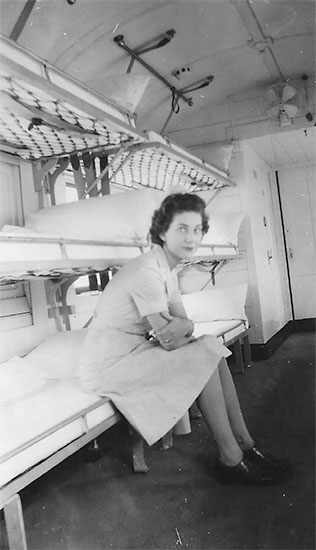
Photograph of 1st Lieutenant Adrienne Van Houten while serving with the 11th Hospital Train somewhere in France in 1944. Courtesy Van P. Keele.
After completing 71 trips and evacuating a total of 21,164 patients, the 11th Hospital Train ceased to operate on 25 May 1945. At that time, the Nurses were placed on detached service (DS) with the 217th General Hospital (stationed in Paris -ed) and the Officers and Enlisted Men were attached to the 302d Station Hospital (Etampes -ed). The 11th Hospital Train was officially inactivated on 31 January 1946 as per Organization Order # 182, Headquarters, Theater Service Forces, European Theater, dated 25 January 1946.
Campaign Awards – 11th Hospital Train
Normandy
Northern France
Rhineland
Ardennes-Alsace
We would like to express our sincere thanks to Larry Burnside for kindly providing numerous photographs of the 11th Hospital Train’s derailment in France. Additional thanks are due to Van P. Keele, son of First Lieutenant Adrienne Van Houten, ANC (N-763859 ) who not only served with the 11th Hospital Train overseas, but was also Assistant Chief Nurse of the 820th Hospital Center (18 June 1945 – 1 September 1945) and Assistant Chief Nurse of the 9th Field Hospital (2 September 1945 – 16 September 1946). Van kindly offered us a number of very interesting photos. The MRC staff are still looking for additional data and material relating to the service of the 11th Hospital Train overseas during WW2, including a complete Personnel Roster.
